
Basic Tibir

The writing under the animals says: Tibir Aka datu.
The art of Tibir is based on the fight between a Cobra and a Mongoose. How does a Mongoose fight a cobra?
First the Mongoose will stand up on his back legs; he chatters and bobs about to insight the cobra to rise up into striking position. We emulate this with the 'Stand like Mongoose / 1st earth posture":
STAND LIKE MONGOOSE
Since it is not practical to leave the hands down in an open posture we hold the hands in the earth posture. Note that in all postures the lower hand floats in front of the solar plexus and the high hand floats in front of the face.

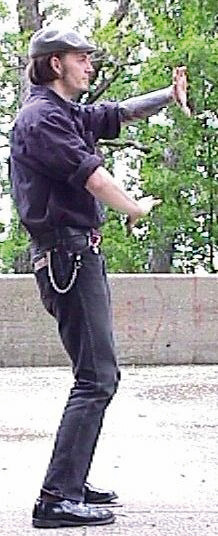
STAND LIKE MONGOOSE
In response to the Mongoose's antics the Cobra rises up to striking posture, to emulate this we assume the "Cobra rises up / 1st Water posture":
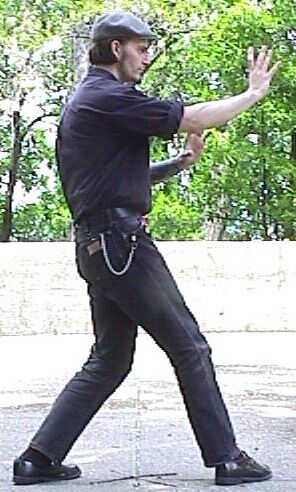

COBRA RISES UP
This posture leads to the primary "response strike" in Tibir: The Split:

NOTE: THIS SEQUENCE GOES FROM RIGHT (step 1) TO LEFT (step 3).
A Cobra does not strike like an adder or a viper. These snakes hunch back, in zigzags of folds, and then straighten out suddenly. A cobra raises up in an upright posture and when it strikes, it falls forward along its length. Note that in the sequence above:
(Step 1) With my weight back, my left hand drops onto the opponent's attack
(Step 2) As I step with my right foot, my right hand rises up facing me (keeping pace with my right foot),
(Step 3) And then while my weight falls on my front foot, my hand turns away from me while it falls forward in an abbreviated arc towards the opponent's face, and then the weight rocks back into step 1.
This motion is an excellent defense against an attack to the face or solar plexus. I have had students throw repeated shots at my face or solar plexus and used only the split as a defense. Properly done, it not only defends against the strike, but also counter strikes effectively!

When the Cobra strikes, the Mongoose stretches along the ground and rushes to the side of the Cobra in an attempt to grab the Cobra behind the head. We emulate this with the "Mongoose stretches along the ground / 1st Fire posture":
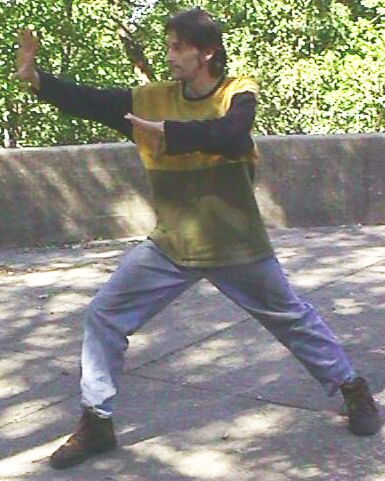

MONGOOSE STRETCHES ALONG THE GROUND
If the Mongoose misses the Cobra, the Cobra turns to track the movement of the Mongoose. We emulate this with the "Cobra turns / 1st Wind posture":


COBRA TURNS
This cycle continues With the Mongoose circling and the serpent turning until the serpent tires or the Mongoose is struck. Even then the Mongoose may continue to circle and attack if he is struck.
The manner in which these postures are used will be touched on below, but first lets examine them in light of weight distribution and our view of our defensive / offensive personal space.
In Tibir we divide our personal space into a centerline region (Ibsi) and the outer circle (Zagsi):

IBSI AND ZAGSI
Think of the circle (Zagsi) as the boundary that you use to keep the opponent's strikes out of the castle, and the Ibsi as the line of engagement. If the opponent strikes we move the hands to push the strike around and past us along the Zagsi circle. One may strike straight along the Ibsi or send a strike arcing along the Zagsi in an abbreviated arc to slam in from the side.
The red dot are Katu, the black dot at center is Tebu (if you donít know Katu, Tebu, earth, Water fire, and air go to the pages prior to this one and study)
Here are weight distributions and relationships to the Ibsi /Zagsi, for the four basic postures given above:

STAND LIKE MONGOOSE
(Both feet are on the circumference/Zagsi and the toes point at the Ibsi/center)

COBRA RISES UP
(Front foot is on the circumference/Zagsi rear foot is on the center/Ibs)

MONGOOSE STRETCHES ALONG THE GROUND
(Front foot is on the center/Ibsi, rear foot is on the circumference/Zagsi)

COBRA TURNS
(Both heels are on the center/Ibsi line)
MONGOOSE PRINCIPLES
The Mongoose waits for the Cobra to strike and then moves on the Zagsi to the safe side of the Cobra. In Tibir we call this safe side the 'OUTSIDE LINE'. To move to the outside line means
"to move to the side of the opponent that is to the outside of his arm so that the arm is interposed between you and the opponent's chest. "
The best case is when both hand and foot are interposed:
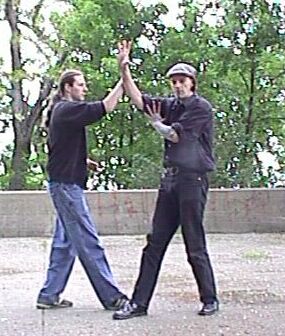
HERE BOTH PERSONS ARE ENGAGED ON THE OUTSIDE LINE WITH HANDS AND FEET.
When on the inside line, the defender ends up being head on with the opponent, and the opponent has an easier time striking with a kick or a punch from his other hand. If the body and feet are on the outside line but the hand is not, the defender is at risk to a throw or counter attack with the fists or feet.

HERE THE DEFENDER ON THE RIGHT, IS ON THE OUTSIDE LINE WITH HIS FEET, BUT IS ON THE INSIDE LINE WITH HIS LEFT HAND. AS A RESULT HE IS OPEN TO A NASTY TAKE DOWN FROM MY RIGHT ARM. THE HANDS AND BODY MUST BE ON THE OUTSIDE LINE EVEN WHEN THE FEET ARE NOT.
In Tibir we always attempt to engage the upper limb at the forearm / elbow, and the lower limb at the knee / shin.
Here are some examples of simple defenses using the four prime postures. All start with a Split engagement.
STAND LIKE MONGOOSE:
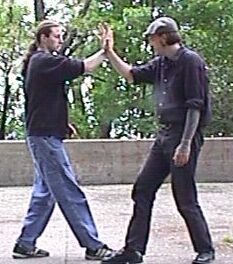
1.Defender (on right) engages the right-handed attack with a split on the outside line (the defender's feet are in the Cobra turns posture).

2. Defender brings his left forearm up under the attacker's right armpit while he brushes the attacker's right hand down, and across the attacker's center/Ibsi. In addition the defenders left knee engages the attacker's right knee from the outside line/Zagsi.

3. Defender uses a Half Circle Decompression (up &forward, down & forward) with his forearm towards the opposite shoulder to force the opponent to cross step (a very unstable posture open to takedown).
COBRA RISES UP:
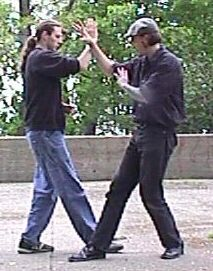
1.Defender (on right) engages the right-handed attack with a split on the outside line (the defender is in the Cobra Rises posture)

2. Defender brings his left hand up and smashes his left palm into the attacker's right ear (or base of skull), while he brushes the attacker's right hand down and across the attacker's center/Ibsi. In addition the defenders right knee engages the attacker's right knee from the outside line/Zagsi preventing the attacker from stepping.
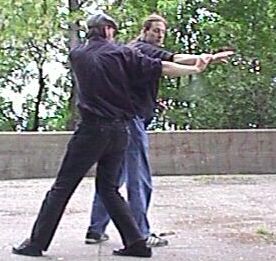
3. Defender shoves attacker's right shoulder forcibly, sending him flying away with his back to the defender (preferably towards a wall or another enemy). He also maintains control over the attacker's right wrist (this may lead to a lock or throw).
MONGOOSE STRETCHES ALONG THE GROUND:

1.Defender (on LEFT) engages the right-handed attack with a split on the outside line (the defender is in the Cobra Rises posture)
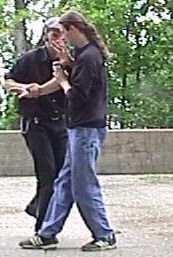
2. Defender brings his left forearm up under the attacker's right armpit, while he brushes the attacker's right hand down and across the attacker's center/Ibsi. In addition, the defenders right knee engages the attacker's right knee from the outside line/Zagsi. Often, in this instance we will bring the left knee in to strike the attacker's right knee. This creates a vicious cross step that the opponent can not resist (see STAND LIKE MONGOOSE step 2 / 3), but being on concrete, and not wanting to send my friend flying into the camera man, I used my right knee.
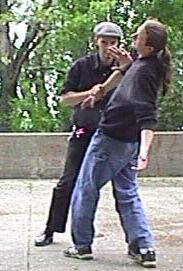
3. Defender uses a Half Circle Decompression (up &forward, down & forward) with his forearm towards the opposite shoulder to force the opponent to cross step (this would be followed by the defender kicking the opponent's left foot across the opponent's right center with his right foot for a smashing take down). Looking at the attacker's left hand in this photo, one might assume the defender is simply relaxed in cooperation, but the desire to break one's fall is so strong in this kind of situation (bent backwards) that his hand is rushing down to try to break his fall!
COBRA TURNS:

1.Defender (on LEFT) engages the right-handed attack with a split on the outside line (the defenders is in the Cobra Rises posture); opponent is trying to use Cobra Turns posture.

2. Defender brings his left forearm up under the attacker's right armpit, while he brushes the attacker's right hand down and across the attacker's center/Ibsi. In addition, the defenders right knee has slammed into the attacker's right knee from the outside line/Zagsi driving it to the opponent's left side.

3. Defender steps with his left foot into the Cobra turns posture (note the hip to hip engagement), while slamming his right palm up under the opponents chin. Looking at the attacker's left hand in this photo, one might assume the defender is simply relaxed in cooperation, but the desire to break one's fall is so strong in this kind of situation (bent backwards) that his hand is rushing down to try to break his fall!
![]()
Page two, further posture | back | home